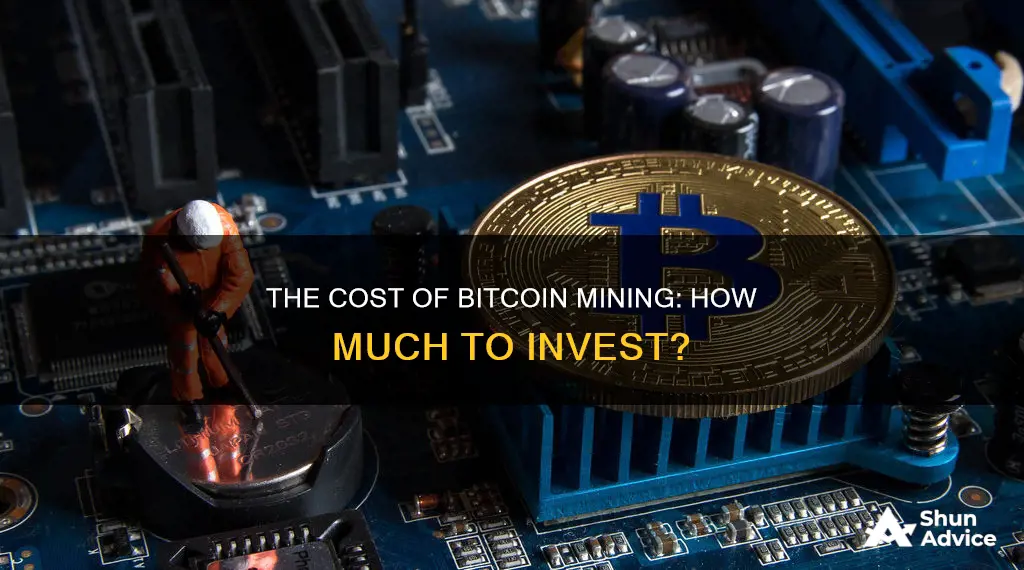
Bitcoin mining is the process of creating new bitcoins by solving complex mathematical problems that verify transactions in the currency. When a bitcoin is successfully mined, the miner receives a predetermined amount of bitcoin. Bitcoin mining requires substantial hardware and software, as well as a significant amount of electricity. The cost of the hardware and electricity required for bitcoin mining can be high, and the difficulty of mining bitcoin increases as more miners join the network. As a result, bitcoin mining may not be profitable for individuals, especially those with small setups. However, it is still possible to make money through bitcoin mining by joining a mining pool or using cloud mining services.
| Characteristics | Values |
|---|---|
| Bitcoin mining reward | 3.125 BTC per block |
| Frequency of reward halving | Every four years |
| Hardware costs | $1,000 to $2,000 for a capable GPU; $10,000+ for an ASIC |
| Electricity costs | $100+ per month for one ASIC |
| Mining pool fees | Varies by pool |
| Bitcoin price | ~$63,000 as of April 2024 |
What You'll Learn

Bitcoin mining hardware
The Bitmain Antminer S21 Hyd 335T is currently the most profitable mining machine, with a hash rate of 335Th/s and a hydrocooling feature. It is also relatively inexpensive at $4,200+. Other profitable machines include the Canaan Avalon Made A1266 and the MicroBit Whatsminer M50S.
When choosing mining hardware, it is important to consider the machine's profitability, efficiency, power consumption, noise levels, and the algorithm it can mine. Profitability and efficiency are key factors, as mining is an expensive endeavour, with high electricity costs. Power consumption impacts profitability, as higher hash rates often result in increased power usage, leading to higher electricity bills. Noise levels are also a consideration, as these machines can range from 50 to 75 decibels, similar to the noise produced by vacuum cleaners.
Finally, the algorithm a machine can mine is crucial. Different cryptocurrencies use different algorithms, so choosing a machine that supports the desired algorithm is essential. Some common algorithms include SHA-256, Scrypt, and Eaglesong.
In summary, successful Bitcoin mining requires a significant investment in specialised hardware, with careful consideration of profitability, efficiency, and algorithm compatibility to maximise the chances of a positive return on investment.
Strategizing Bitcoin Investment: A Long-Term Guide
You may want to see also

Bitcoin mining pools
Mining pools are operated by third parties and coordinate groups of miners. The most common type of mining pool is a proportional mining pool, where miners send shares of work to the pool until a block is found. Miners then receive rewards proportional to the number of shares they submitted for that block.
There are several common payout schemes used by mining pools:
- Pay per share (PPS)
- Pay per last N shares (PPLNS)
- Pay per share plus (PPS+)
- Full pay per share (FPPS)
Some popular Bitcoin mining pools include Foundry USA, Binance Pool, and Ultimus Pool.
While joining a mining pool can increase the chances of receiving a reward, it also comes with some disadvantages. Individuals give up some autonomy in the mining process and are typically bound by terms set by the pool. Additionally, any potential rewards are divided among participants, resulting in a lower share of earnings for each individual.
Bitcoin: Speculative Investment or the Future of Currency?
You may want to see also

Bitcoin mining profitability
Hardware Costs
Bitcoin mining requires substantial hardware in the form of a powerful computer with a specialized graphics processing unit (GPU) or an application-specific integrated circuit (ASIC). These can be costly, ranging from $1,000 to $2,000 for a capable GPU, while ASICs can cost tens of thousands of dollars. The more powerful and efficient the hardware, the higher the chances of profitability.
Electricity Costs
Bitcoin mining consumes a significant amount of electricity, and these costs can quickly add up. The energy consumption of Bitcoin mining is a major concern for environmental groups and can limit profitability. The electricity costs for running an ASIC can be equivalent to the energy used by half a million PlayStation 3 devices, according to a 2019 report.
Bitcoin Price Volatility
The volatile nature of Bitcoin's price makes it challenging to determine if mining efforts will be profitable. Since November 2021, Bitcoin's price has fluctuated between $20,000 and over $73,000. This uncertainty makes it difficult to predict if the rewards will outweigh the high costs of mining.
Competition and Difficulty
As more miners join the network, the difficulty of mining increases. This increased competition means that miners need to invest in more powerful hardware to have a chance at earning rewards.
Mining Pools
Joining a mining pool can help distribute the high costs of mining. Pools allow miners to combine their resources and increase their collective computing power. However, the rewards are also shared, so the potential payout is lower.
Taxation
Taxes can also impact the profitability of Bitcoin mining. In some jurisdictions, mined Bitcoin may be taxed as income or capital gains, reducing the overall profitability.
Regulatory and Legal Risks
The regulatory landscape for Bitcoin mining varies across jurisdictions. Some countries, like China, have outlawed Bitcoin mining altogether. It is crucial to understand the legal and regulatory stance of the relevant authorities before investing in mining equipment.
In conclusion, while Bitcoin mining can be profitable, it is a complex and costly endeavour. Miners need to carefully consider the hardware and electricity costs, the volatile nature of Bitcoin's price, the increasing competition, and the potential tax and regulatory implications.
A Small Bitcoin Investment: Worth the Risk?
You may want to see also

Bitcoin mining risks
Bitcoin mining is a complex process that requires a lot of computing power and electricity. It can be a risky endeavour due to the high upfront costs of equipment and the ongoing electricity costs. Here are some of the risks associated with Bitcoin mining:
- Price volatility: The value of Bitcoin has fluctuated widely since its introduction in 2009, making it difficult for miners to know if their rewards will outweigh the high costs of mining.
- Regulation: Cryptocurrencies like Bitcoin are not embraced by many governments and are often viewed skeptically as they operate outside of government control. There is a risk that governments could outlaw Bitcoin mining, as seen in China in 2021.
- Financial risk: Bitcoin mining requires a significant investment in equipment and electricity, with no guarantee of a return.
- Environmental impact: Bitcoin mining consumes a large amount of energy, leading to concerns about its environmental impact and carbon footprint.
- Electronic waste: Large mining firms generate a significant amount of electronic waste as they frequently upgrade their equipment to stay competitive.
- Heat generation: Mining equipment produces a lot of heat, resulting in increased cooling costs.
- Security risks: Cryptocurrency mining can expose users and their devices to security risks, such as malware and phishing attacks.
- Network competition: The difficulty of Bitcoin mining increases as more miners join the network, making it harder to earn rewards.
A Beginner's Guide: Investing in Bitcoin in Qatar
You may want to see also

Bitcoin mining rewards
The current reward for mining Bitcoin is 3.125 BTC per block. This reward is halved roughly every four years or every 210,000 blocks. The reward began at 50 BTC per block and will continue to halve until all 21 million BTC are mined, which is expected to happen in 2140.
In addition to the block reward, miners also receive transaction fees from the transactions included in the block. These fees are not set and vary based on network conditions, such as the number of transactions.
The process of mining Bitcoin involves solving complex mathematical problems or cryptographic puzzles. It requires specialized hardware and a significant amount of electricity, making it a costly endeavour. The difficulty of the problems increases as more miners join the network, and the reward decreases over time, making it increasingly challenging to turn a profit from Bitcoin mining.
To improve their chances of earning a reward, miners often join mining pools, where they combine their computing power and share any rewards received.
UK Guide: Getting Started with Bitcoin Investments
You may want to see also
Frequently asked questions
Bitcoin mining requires a substantial investment in hardware and software. A dedicated mining system can cost as much as a new high-performance desktop computer, sometimes more. For example, the Antminer ranges from $1,950–6,318, the Whatsminer from $662–$9,338, and the Canaan Avalon from $569–$1,830.
The amount of money you can make from Bitcoin mining depends on several factors, including the cost of electricity to power the mining machines, the speed of your miner(s), its cost, and mining pool payouts. Joining a mining pool can increase your chances of turning a profit, but you will have to share your rewards.
The biggest risk of Bitcoin mining is that you won't make back your start-up costs. Other risks include price volatility, regulatory changes, and the environmental impact of mining.
To get started with Bitcoin mining, you will need to buy an ASIC miner, choose a location to set it up, set up a crypto wallet, and join a mining pool.







